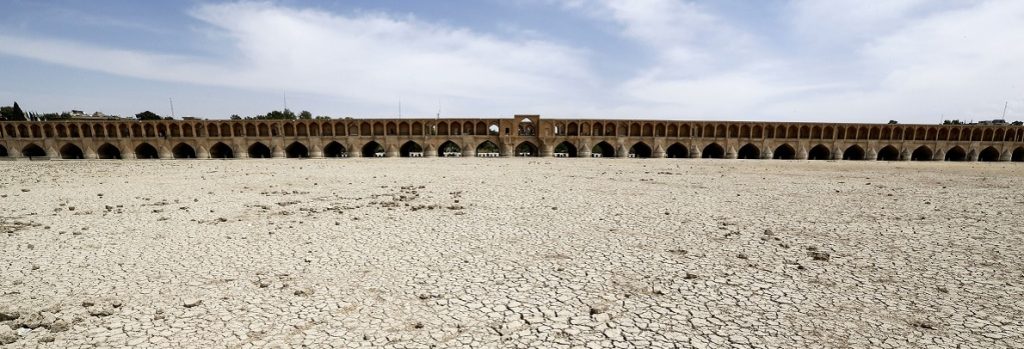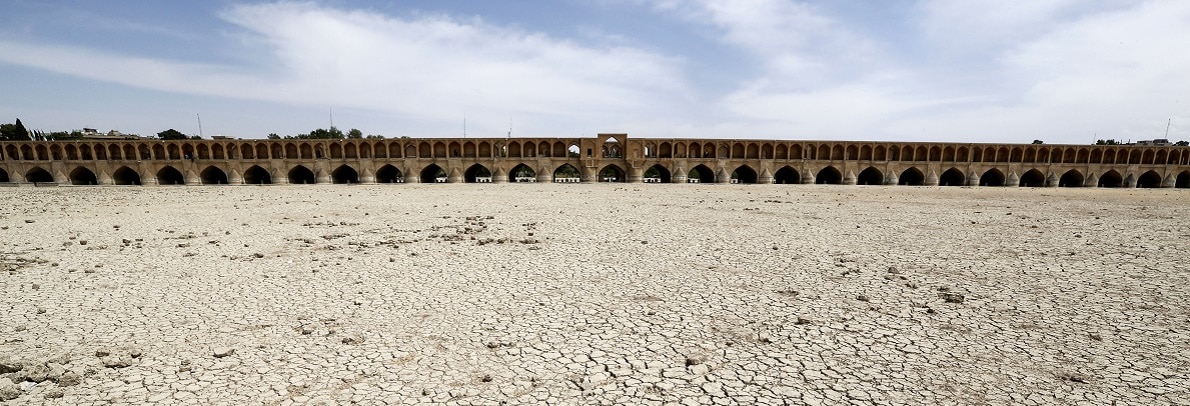By: Shahin Modarres, Yasmina Dionisi and Filippo Cimento.

May God protect this land from foe, drought, and falsehood. This famous prayer engraved in the heart of Apadana Palace in Persepolis by the Persian Shahanshah Darius the Great has a particular meaning to Iranians, but why? Where do we stand 2570 years after these words were said?
A nation without water is a nation without the most crucial flow of life. Water is undeniably recognized as a priority for human sustainable development and linked to all other environmental and societal concerns.
It should come as no surprise then that the importance of water, and its role as a vital commodity, considerably increase in arid and desert areas. These, specifically, are regions where the natural phenomenon of drought does not only frequently occur but bears rather alarming economic, social and environmental costs.
Iran is no stranger to an arid climate. Located 20 to 45 degrees north, more than 90 percent of the country’s area is dry. The question of water drought is relevant in such a country whose society and economy can be said to be water-dependent: water has played a key role in its society since the establishment of the first known human empire in the southwestern part of Iran. Drought should be addressed as an urgent concern. Three major consequences of water drought in Iran are delved into in this article: respectively on the agricultural sector, on energy production in regards to hydroelectricity, and ultimately on internal migration.
Agriculture
Drought primarily affects the agriculture sector. Studies on the Iranian agricultural sector are limited but its major role in Iran’s political economy and food security can still be denoted. The country aims towards becoming fully self-sufficient in food production and food security remains a priority in Iran.
Arid areas like the Middle East rely on irrigation. Reportedly, in what is the water used for agriculture, irrigation accounts for about 20% of the global agricultural evapotranspiration. What has been evident is that Iran's agriculture is heavily impacted by water availability. Dating back to July 1968 when the Nationalization of Water Resources act was enacted, and all water in the country was considered a natural wealth and belonging to the nation; the relation between Iran’s agricultural sector and water use hardly goes unnoticed: Iran’s agricultural sector is, as a matter of fact, responsible for about 90% of water consumption at a national scale. From 2005, 98 percent of all agricultural raw materials in Iran were produced from irrigated lands.
Scholars find the main theme in this sense is the one of responsibility. This responsibility is principally visible in the action of the government in what concerns the resources management. For example, George Joffe claims that “Waste needs to be eliminated”, and “The real solutions, therefore, are to find ways of using water more efficiently and rationally, rather than fighting to retain control”. This could be done by reducing the amount of water lost through leaks which stays at a level of 50% of all water piped. Moreover “cost-effective methods of desalination through solar power will ultimately be the key to survival”. It is self-evident that Iran is not going in this direction, on the contrary, there is an increasing process of irresponsible exploitation, that in most cases reveals being without any vision. About this Iraj Emadonin says that “Farmlands under irrigation are estimated to comprise around 8 million hectares.” And since “Groundwater plays a very important role in Iran’s agricultural operations”, Roohollah Noori affirms that a portion of nearly “77% of Iran’s land (2021) is under extreme groundwater overdraft, where the rate of human uptake is more than three times higher than the rate of natural recharge.”
Hydro-electricity
Drought is halting the country’s desire to transition to hydroelectric reliance for energy. Iran uses water power to generate electricity. Still, if hydroelectric power stations have operated in the country for over half a century, the percentage of electricity that actually originates from these has considerably decreased over the course of the last decade. 40 years ago, 37% of the total electricity in Iran was produced with hydroelectric power stations. As of 2007, that percentage amounted to only 8%. Nevertheless, environmental concerns and increased awareness of the limited supplies of fossil fuels have been pushing the country to seek clean and renewable hydroelectric power. Such overreliance posed limits within the government as it was pushed to subsidize fuels, for individual energy consumption.
What is sought out as a renewable alternative is a hydroelectric power, but it is clear how that a drought crisis makes it far from favorable. This comes at a dangerous price, considering Iran suffers from frequent shortages of power.
The level of energy production is influenced by different factors. The manifestation of drought is one of the most influential ones. In particular, the negative impact of this phenomenon is confirmed by Kaveh Madani, who states that “reservoirs, which are vital for farms, communities, and hydropower have fallen to dangerous lows”.
Different studies have been conducted on the topic, describing the relation between dry climate conditions and hydroelectric production. Saeed Jamali believes that “The expected climate warming could intensify droughts and dry spells, bringing to hydropower generation reduction, which is expected at the Saymareh, Saz Bon, Garsha, and Koran Bozan basins.”More in detail “because of insignificant streamflow reductions since 2020, hydropower production may not change considerably during this period. However, serious hydropower generation deficit is expected by the 2050s and 2080s”. But those are not the only regions that will be affected, in fact in Sadat Mousavi’s opinion is that climate change has the potential to significantly alter the hydropower generation in the Dez Dam basin. The results of the study showed a reduction in the flow of water and electricity generation for the Bakhtiari reservoir.” So, the scientific community is concordant in the necessity of seeking solutions. For instance, Pouya Ilfaei proposed the ideation of a management strategy of energy that works in a more efficient way, thanks to big data analysis.
Internal migration
The ultimate consequence of drought will be internal migration.
In 1985, the United Nations Environmental Programme coined the term “environmental refugee”. It is known worldwide that human migration is largely affected by changes in climate and drought strikes are a considerable factor that causes the displacement of people, notably from rural centers to the cities. Climate change has been the most compelling cause for environmentally-induced migrations: the drought phenomenon has been classified as a slow-onset change, and scholars have highlighted how slow-acting processes lead to more long-term migrations. Worse, part of the country may become inhabitable.
Drought-prone areas in Iran, around Lake Urmia, the Southern part of the country, and Khuzestan, for instance, host rural populations. These are largely dependent on resources such as water, soil, and crops.
Not alarmingly Iran is experiencing a rapid migration from rural areas to urban centers and today over 75 percent of the population live in urban areas, the capital hosting 18 of them.Even worse, the abovementioned drought-prone areas are at risk of becoming inhabitable.
As mentioned above, scholars' voice agrees in considering the dangerous consequences of internal migration. First, Ali Mirchi underlines that “mass migration will increase more than we have ever seen” if “villages and rural areas run out of water, and livelihood will not be sustainable anymore”. Shahrzad Khatibi adds that “unplanned and irregular expansion of the main cities has contributed to overpopulation.” From the latter different problems derive, such as “urbanization and increasing water demand, while there is no match between demand and water availability”. The government should “reverse process of migration from the large cities of the country to smaller towns. Like in Tehran, where 20% of the population lives, the government should consider different short-term and long-term policies in order to decrease economic attractiveness”. The adoption of this kind of strategy is fundamental in order to avoid discontent related complications. In this regard, Rasoul Sadeghi warned that “Low levels of migration effectiveness underpin limited population redistribution. Spatial patterns reflect socioeconomic inequalities” which are relevant and develop in a gap between rich cities and underdeveloped countryside. Along with this situation, there has been “no policy concerns about housing costs, traffic congestion in destination areas.” But there is an even more complex process, internal to Tehran where overpopulation has made spatial inequality the distinguishing feature of urban unsustainable development.
Conclusion
As this conclusion is being written Iranians in different regions of the country are protesting against the mismanagement of the country's water resources whilst facing violent suppression by security forces. People in Isfahan have been peacefully standing where once Zayande Roud river lived, for more than a week now. Other cities particularly from the Southern and Central regions of the country are joining them to show their concern regarding a concerning lack of water resources. Agriculture and all related products face an unstable state where in many cases there are exist no sufficient water resources. Iran's source of hydroelectricity has also been seriously threatened by the same growing drought. The combination of both elements mentioned is generating a South to North pathway of internal migration, which foresees overpopulation in regions already facing the same problem on a more minor scale. Internal migration derived by drought is introducing many catastrophic factors, growing inhabitant zones is the least.
